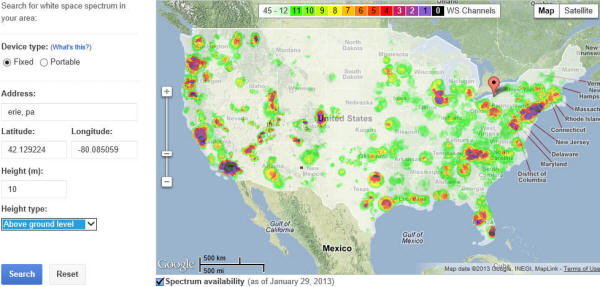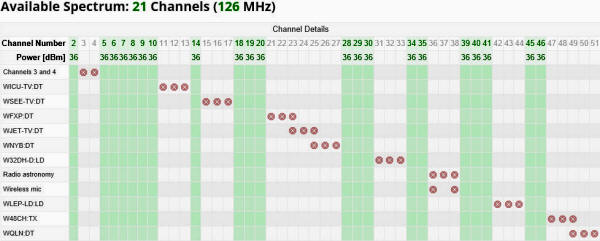Google's White Spaces Spectrum Database |
|
1 | 2 | 3 | 4 | 5 | 6 | 7 | 8 | 9 | 10 | 11 | 12 | 13 | 14 | 15 | 16 | 17 | 18 | 19 | 20 | 21 | 22 | 23 | 24 | 25 | 26 | 27 | 28 | 29 | 30 | 31 | 32 | 33 | 34 | 35 | 36 | 37 There are not many technical realms where Google engineers have not either entered or created. Wireless connectivity is key to their continued dominance in the information domain, so they understandably have a vested interest in the "white space" spectrum debate. White space comprises portions of the electromagnetic spectrum where bands are either unlicensed or where licensed bands are or will be up for grabs. An example of the former is the 2.4 GHz Wi-Fi band, and an example of the latter is some parts of the broadcast television band that is being vacated in areas. Although this information is a few years old, it shows how Google was working early−on with the Federal Communications Commission (FCC) to build a real-time database of what they term "dynamic spectrum" in order to provide useful information about available white space (now directs here) to both users and providers. A separate database is available for fixed and mobile spectrum. Enter your location of interest and the map zooms into that region. For instance, in my town (at the time) of Erie, Pennsylvania (see marker on map below), as of January 2013 when this was first posted there were 21 channels available (the database was temporarily locked for new entries), including three used for radio astronomy. Interpreting the map is sort of opposite of what you would expect. A more appropriate title would be "map of unavailable white spaces," since the more concentrated the color coded areas are, the less chance any spectrum is available. Not surprisingly, regions in and around large cities have the least amount of white space for use. There is a big push by smart phone manufacturers to enable users to access copious amount of data and at blazing download speeds at reduced or no cost, so a major build-out of wireless hotspots is being undertaken. I posted a headline story that addresses the effort: "Smartphone Party Ending for Wireless Carriers," and "Small Cells with Wi-Fi Set to Reshape Wireless Communications Market." Per their website: "Google is working to enable dynamic spectrum sharing while protecting licensed bands. Our database is designed to allow the same spectrum to be shared, without interference, between multiple users, such as government agencies, licensed commercial users and individuals. This means that if part of the spectrum is being used in California, but available in Louisiana, those users will know. " Hat tip to Bob Davis for letting me know about it. Google Spectrum Map
Google Spectrum Table
Posted January 23, 2022 |
 "
"
